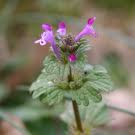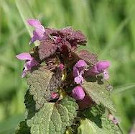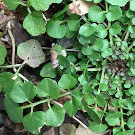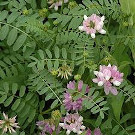5–7 minute read
Routine Care
mulching
Apply mulch after the ground has frozen but before the coldest temperatures arrive. Mulching before the ground has frozen delays plants from entering dormancy, increasing the likelihood of injury from a cold snap. Early mulch also can attract rodents looking for a warm over-wintering site.
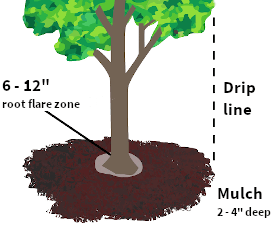
Find the best mulch for your situation
How to apply mulch
watering
Water newly-installed or evergreen plants if weather conditions have been dry
- Choose warm days for watering, because plants cannot take up water if the ground is frozen.
- Water retains heat, so watering just before a cold snap can help plant roots survive bitter temperatures. </li>
houseplants
- Let your houseplants rest. Most are semi-dormant in the short days of winter, needing less water and no fertilizer. The major causes of houseplant deaths during winter are over-fertilizing, over-watering or under-watering, and improper light.
- Watch for indoor insect pests. Most can be controlled easily with insecticidal soap.
Special tasks
bulbs
Check stored bulbs, tubers, and corms such as dahlia, caladium, and gladiolus. Discard any that are soft or rotting and move the healthy ones to a drier place. If you find shriveled roots or tubers, slightly moisten the material in which they are stored.
Fertilize spring-flowering bulbs to help fuel next year’s flowers. Spread a balanced fertilizer such as 10-10-10 around the new shoots when one inch of growth is visible, using one rounded teaspoon per square foot.
planting & Propagating
Take hardwood cuttings of many landscape plants like crape myrtle, forsythia, holly, hydrangea, juniper, flowering quince, spirea, and weigela.
pruning
| Jan | Feb | Mar | Apr | May | Jun | Jul | Aug | ||||||||||
|---|---|---|---|---|---|---|---|---|---|---|---|---|---|---|---|---|---|
| TREES | |||||||||||||||||
| shade | |||||||||||||||||
| bleeder | small branches | ||||||||||||||||
| fruit | |||||||||||||||||
| SHRUBS | |||||||||||||||||
| summer-blooming | after bloom | ||||||||||||||||
| spring-blooming | after bloom | ||||||||||||||||
| broadleaf EG | dieback | ||||||||||||||||
| needle EG | |||||||||||||||||
| HERBACEOUS | |||||||||||||||||
| grasses | |||||||||||||||||
| flowers | pinch, deadhead | ||||||||||||||||
Prune broken branches, including ‘bleeder’ trees like maple, birch, elm, dogwood and styrax.
problems
Frosts & Freezes
Siting
Because cold air settles, there is usually more damage in low-lying areas. Plants on the east or south side of a building or wall are the most likely to be damaged. These areas warm up quickly after a frosty night and typically warm up faster in spring. Plants don’t know whether or not to stay dormant.
Damage
Frost damage will be less if there is some wind or cloud cover. Spraying plants with water before the sun strikes the leaves can reduce or eliminate damage from mild frosts.
Freeze damage usually does not occur until the air temperature is 30°F. A common form of damage is split bark on the southwest side of a thin-barked tree or shrub, caused by the sun’s rapid warming following an overnight freeze. Wrap trunks of young trees with cloth or paper for protection. Note that it often takes weeks/months before the damage is visible — azaleas may not show damage until the first hot spell.
Remove snow by gently sweeping branches upward to lift off snow without further stressing the limbs. Do not remove ice: frozen, laden limbs are very brittle and snap easily if bent the wrong way. Young branches often recover.
Protection
Protect roots of tender plants with a layer of mulch around the crown or a covering of conifer branches. For special plants, make a wire cage around the plant and fill it with leaves.
By trapping radiant heat from the ground, you can increase plant hardiness by more than 10 degrees.
- Covers should go all the way to the ground so that heat does not escape, but use stakes to prevent them from touching the plants.
- Burlap, bed sheets, blankets, and agri-fabric are preferred, but plastic buckets work as well. Plastic sheets and metal buckets are not recommended because they overheat too rapidly once the temperature rises.
- Be sure to remove the cover once the temperature is rising to prevent cooking the plant.
Pavement
Environmentally-friendly choices for traction on slippery surfaces include sand, cat litter, and ashes. Runoff from ice-melting salts can harm plants, while runoff from fertilizers can contaminate streams and groundwater.
weeds
For common weeds not mentioned below, try this weed gallery. You can check for the toxicity, groundwater risk and persistance of many weed products in Toxicity of Lawn Chemicals.
- Watch for winter annual weeds. Hand-weed, apply preemergent in September or October when night temperatures are consistently 55–60° or apply a selective post-emergent when the temperature is above 40° all day long. Post-emergents are most effective when weeds are actively growing. While spring is best, you can also apply them in the fall while the weed is establishing its winter rosette.
- Treat perennial weeds such as wild onion and wild garlic with a broadleaf herbicide when temperatures are above 50°. Be careful to distinguish mock strawberry, an invasive alien, from our native barren strawberry.
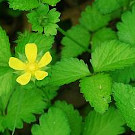 weed mock strawberry
weed mock strawberry wildflower barren strawberry
wildflower barren strawberry - Control invasive vines and unwanted tree saplings.
- For saplings that are too large to pull, cut off close to the ground and clear away debris. Immediately paint or spray the exterior and the cut surface with a 15–25% solution of glyphosate --- waiting more than 5 minutes can prevent absorption. For a larger stump, only the outer two-thirds is live wood and needs treatment.
- English ivy control differs by season. In fall, hand-pull vines and re-visit periodically to remove any residual new growth. In spring, hand-pull or use herbicide.



